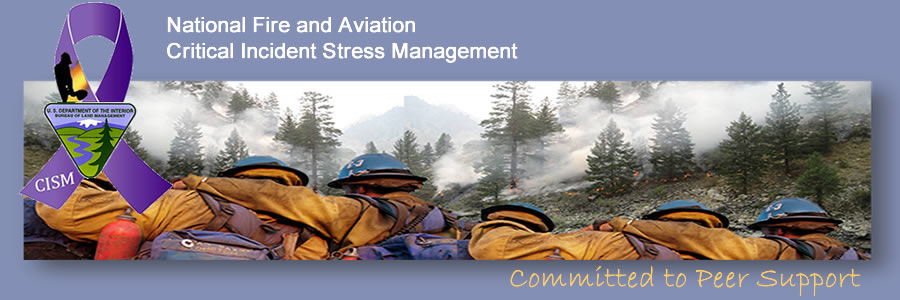Main Print Heading
Print Subheading
Under Construction
Critical Incident Stress Management
Critical Incident Stress Management Critical Incident Stress Management (CISM) is an intervention protocol developed specifically for first responders (fire, law enforcement, etc.) dealing with traumatic events. It is a formal, highly structured and professionally recognized process for helping those involved in a critical incident. Crisis intervention or "CISM" aims to reduce the intensity of an individual's emotional, mental, physical and behavioral reactions to a crisis. Another purpose is to help individuals return to their level of functioning before the crisis. Functioning may be improved above and beyond this by developing new coping skills and eliminating ineffective ways of coping, such as withdrawal, isolation, and substance abuse.

Wildland fire and aviation personnel suffering from such symptoms have shown to benefit significantly from Critical Incident Stress Management (CISM). CISM is not therapy, and does not "cure" people's stress responses. Rather, CISM is a proven means of assisting people in their own healing by reducing the severity and longevity of symptoms, and thus restoring them to function much sooner. It is not perfect, and some people suffering from traumatic shock may go on to develop posttraumatic stress disorder (PTSD), but for the vast majority, CISM brings significant benefits. Read More
Critical Incidents
.A critical incident is any unexpected, traumatic event that affects an individual’s feelings of personal safety, their ability to perform daily activities, and their ability to concentrate on their normal job duties. Simply put, a critical incident is a traumatic event (or perceived life-threatening event) that has sufficient power to overwhelm an individual's ability to cope. A critical incident is not defined by the incident itself; it is defined by individuals and/or an organization’s reaction to what occurred.

In a career where you perform hazardous duties and you risk personal safety as part of the job, a critical incident is the one that disturbs the balance between thinking and emotions. Read More
Traumatic Stress: Shock, Impact, Recovery
Various researchers have identified several predictable responses following a critical incident. These responses can be reduced to three principle phases: shock, impact, and recovery. The shock, impact, and recovery response pattern can vary in intensity and duration, and is commonly seen within the experience of posttraumatic stress and posttraumatic stress disorder.
Shock—psychological shock (P-shock) is often the initial response to a traumatic incident. P-shock is comprised of a host of discernible reactions including denial, disbelief, numbness, bravado, anger, depression, and isolation. P-shock reactions, although common following trauma, are not limited to trauma.
Impact—after the passage of some time, the amount of time differs for different people, there is impact. Impact normally involves the realization that “I could have been killed” or “This was a grave tragedy.” These thoughts and the feelings that accompany them can be overwhelming. Firefighters should never be returned to full duty while they are working through any overwhelming impact of a traumatic incident.

Recovery—recovery does not follow impact as a discreet event. Instead, with proper support and individual processing, impact slowly diminishes. As impact diminishes, recovery begins. A person can experience any degree of recovery. No or little recovery can result in lifetime disability. Full recovery involves becoming stronger and smarter, disconnecting the memory of the incident from any enduring disabling emotional responses, and placing the incident into psychological history. Without recovery, persons remain victims of trauma. With recovery, they become survivors. Read More
CISM Programs
Critical Incident Stress Management (CISM) is a comprehensive, integrated, systematic and multicomponent crisis intervention program. Read More...
- Frequently Asked Questions
- Joshua Green
- Nicholas Jones
- Mark Lee
- Jaycee Wayane
- Matthew Cumberland
- Alexander Jacobs
- Christian Dexter
Netus et malesuada fames ac turpis egestas. Vestibulum tortor quam feugiat vitae ulmper. mcorper pharetra turpis pulvinar facilisi.
CISM and EAP
While EAP services include response to crisis and trauma, EAP cannot provide peer support which is the foundation of the ICISF intervention models we utilize. The Peer Support Program can be seen as the connecting link between the employees and EAP services. The Peer Support Program and Employee Assistance Programs often complement each other to help employees, especially for follow-up care after crisis interventions services. EAP information and education resources are provided following crisis interventions for follow up care. EAP services are almost always recommended by Peer Support Groups for any needed follow-up care.
Vestibulum erat wisi condimentum sed commodo vitae ornare sit amet wisi. Aenean fs eu erat. Aliquam erat volutpat. Nam dui mi tincidunt quis accumsan facilisis luctus metus

Social Media Connect